Flavius Daniliuc’s (188cm/6’2”, 79kg/174lbs) young life in professional football reads as a very eventful one. The right-footed Austrian centre-back started out at Admira Youth before moving to Rapid Youth in 2010 and shortly after, he joined the Real Madrid youth ranks in 2011.
He ended up switching European giants in 2015 when he moved from Madrid to Bayern Munich. He never made a first-team appearance for Bayern but did play an important role in two UEFA Youth League campaigns — in 2019/20, guiding Bayern through the group stage unbeaten and into the Round of 16 when they narrowly lost out on penalties to Dinamo Zagreb. Daniliuc was the captain of that team.
The nomadic Daniliuc spread his wings once more when he left Bayern and made his move to Ligue 1 with Nice in the summer of 2020. In France, he laid down the first building blocks of his life in senior football but never really cemented a place in Les Aiglons’ starting eleven. This leads us to 2022, when just days before the summer transfer deadline, Daniliuc departed Nice and embarked on a trip to another new destination for him — Italy’s Serie A, where he’ll play with newly-promoted Salernitana.
Daniliuc has lived a life so far, to say the least. He’s got a lot of experience in his young career — and a unique experience to that of many others. This ultimately counts for little if his potential doesn’t actually manifest in senior football but for us, there’s a lot to like about Daniliuc. He’s still just 21 years old and has emerged as a leader a lot of where he’s been in the past — captaining Bayern’s U19s, Austria’s U19s when he was there, and most recently Austria’s U21s as well.
This, along with the brave and bold decisions he’s taken in his young career, hints at a strong character and leadership ability but what else is there to note about Daniliuc? Why should you care about him and his €5m move from Nice to Salernitana?
This Flavius Daniliuc tactical analysis and scout report aims to provide some in-depth analysis of Daniliuc’s game based on his time at Nice. We’ll aim to highlight some key strengths and weaknesses in the young centre-back’s game, the roles he played in Nice’s tactics during his time in France and why we feel he retains the potential to be an exciting player.
Daniliuc on the ball in wide areas
Though primarily a centre-back, Daniliuc played almost half of his minutes at right-back during his time at Nice and even got some minutes at left-back. This will skew data a little bit when comparing his performance with other centre-backs due to the very different role he sometimes played.
Regardless of whether he was playing as a centre-back or a full-back, though, it remained consistent that Daniliuc was quite heavily involved in the early possession phases. He is perhaps a bit of a safe passer too much of the time as he has the ability to drive the team forward and break lines more frequently than he does. Nonetheless, this has still been a prominent part of his game.
When deployed at right-back, a big part of Daniliuc’s game was to drive the ball and team forward into the opposition’s box, breaking the last defensive line with his passing and/or carrying.
Daniliuc didn’t bomb it up and down the wing all game in the fashion you might expect from PSG’s Achraf Hakimi, for instance, but he is quite quick and agile with good stamina to offer options on the wing throughout the game in more advanced positions and deeper positions.
It was common to see Daniliuc remain quite deep during build-up and the ball progression phase, offering a short passing option to the side of his centre-backs and midfielders who could get his head up and use his long passing ability to get the team forward into a threatening position.
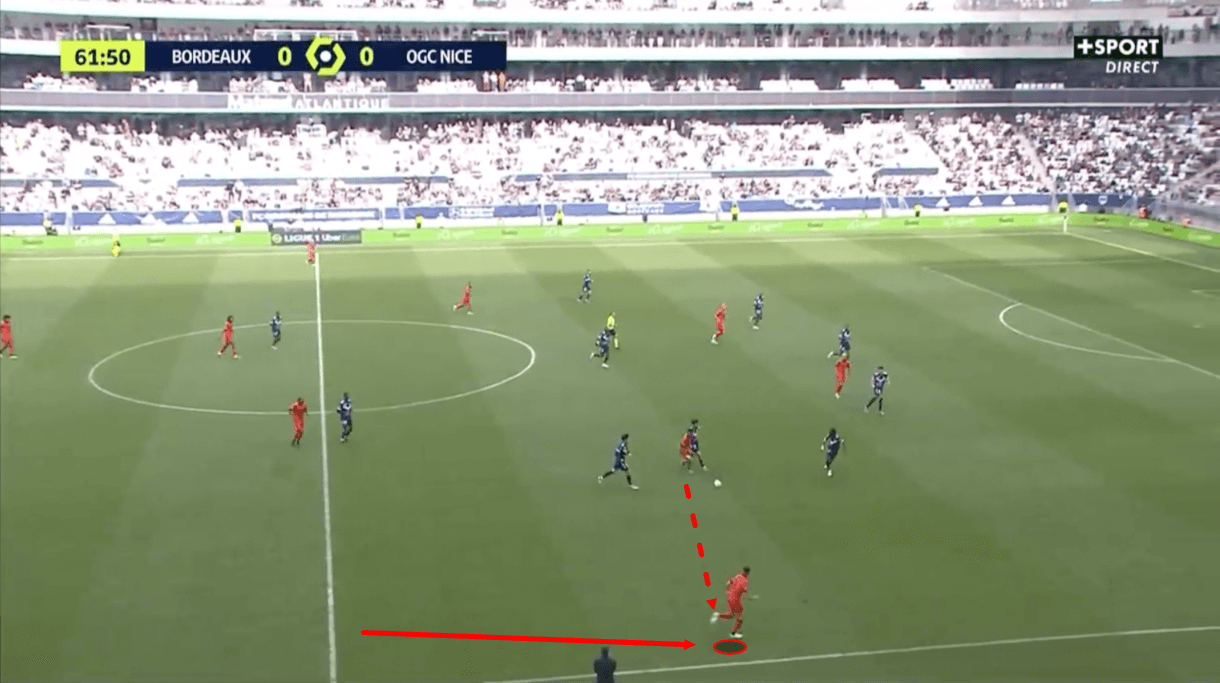
We see an example of Daniliuc providing a short passing option to the side of his midfield teammate while playing at right-back in figure 1. Where many full-backs might be found in the most advanced line of attack looking to provide width there at this stage, Daniliuc remains a little bit deeper, offering an option to the side and slightly behind the ball carrier.
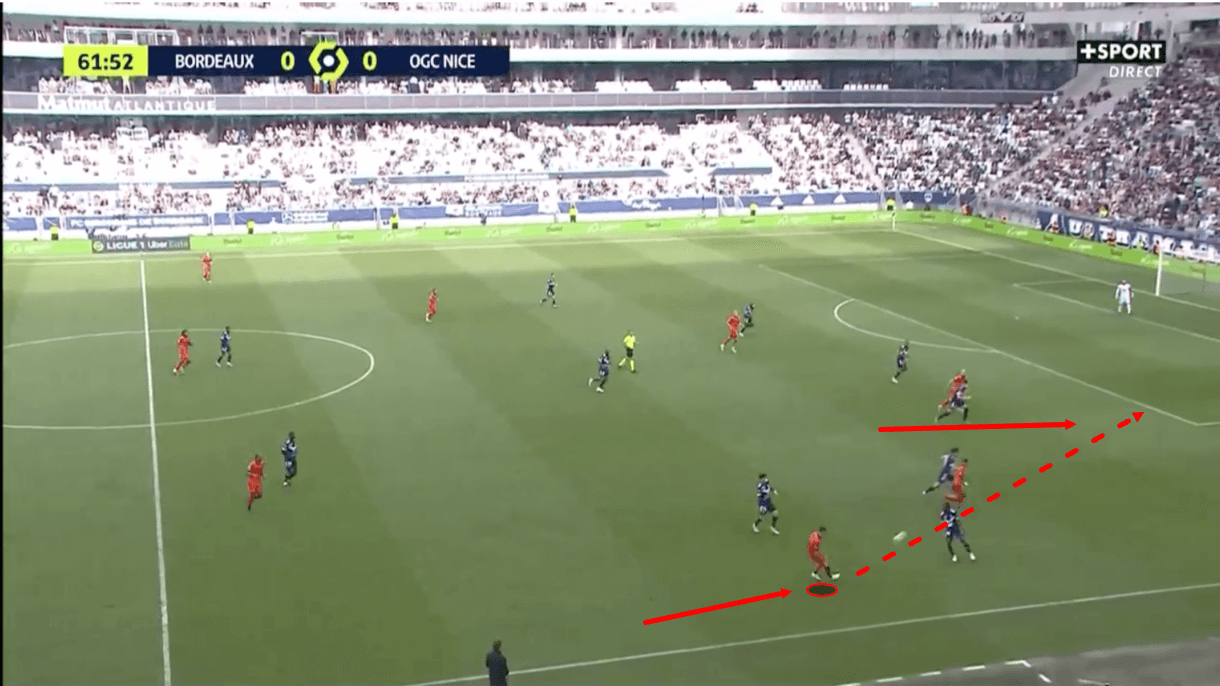
After receiving the ball and attracting some pressure, the passer who played the ball to Daniliuc in the first place makes a run out wide dragging a defender with him while one of Nice’s forwards begins making a move in behind the nearest defender. Daniliuc spots this movement, as we see in figure 2, lofting a through ball into the runner’s path to progress his team to the edge of the opposition’s box.
Again, it might be common to see full-backs or wing-backs look to drive down the wing themselves, taking defenders on when they’re in a position like this but Daniliuc is, again, primarily a centre-back and not a flying wide player. His game, when deployed on the wing, was more about finding space on the ball to get his head up and pick out some movement ahead of him to target with a forward pass, as we see in this example.
Even when deployed as a centre-back, Daniliuc likes to break lines with his carries when possible, advancing into the deep right half-space/wide area from where he likes to get his head up and try to progress the team in some way, even playing some crosses from this position as a centre-back at times. He can be a dangerous deep-lying creator when given space to drive forward into these positions.
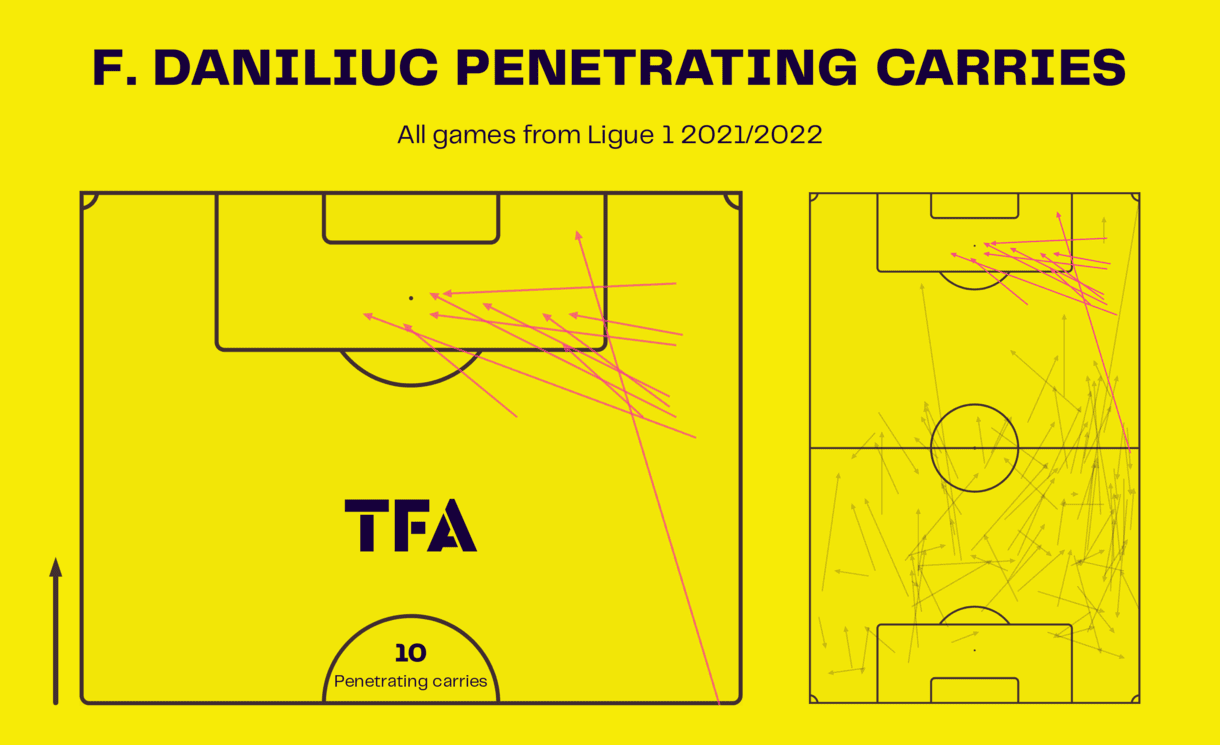
Figure 3 shows Daniliuc’s carries across the pitch from 2021/22 Ligue 1. We can see the types of runs he likes to make on the ball in this image. He remained relatively deep for the most part, keeping the opposition’s box in front of him. On 10 occasions, he carried into the penalty box and the majority of those runs started from in front of the box too, not beside.
Daniliuc on the ball centrally
Whether he’s positioned wide or centrally, Daniliuc likes to be on the ball either in the middle third of the pitch or just on the edge of the final third with space around him and dangerous movement ahead of him to target with his next move on the ball.
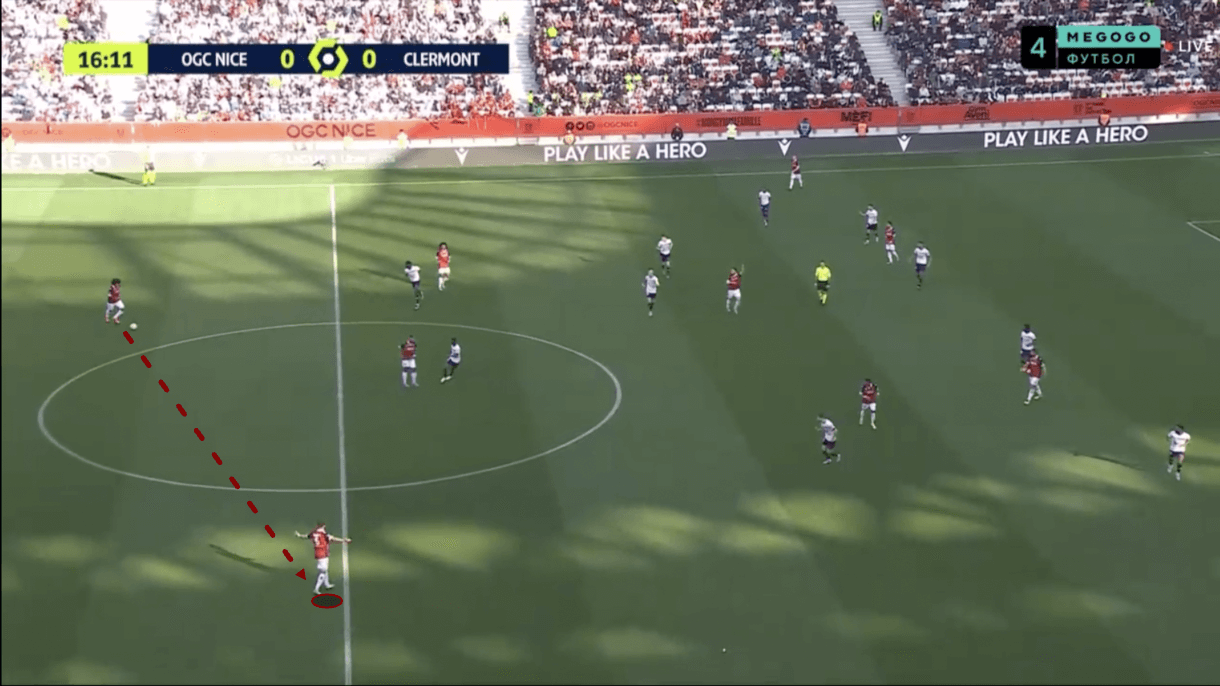
Figures 4-6 show a typical example of where Daniliuc likes to be and what he likes to do, in possession. Firstly, the centre-back clearly wants the ball in figure 4, visually calling for it from centre-back partner, Dante.
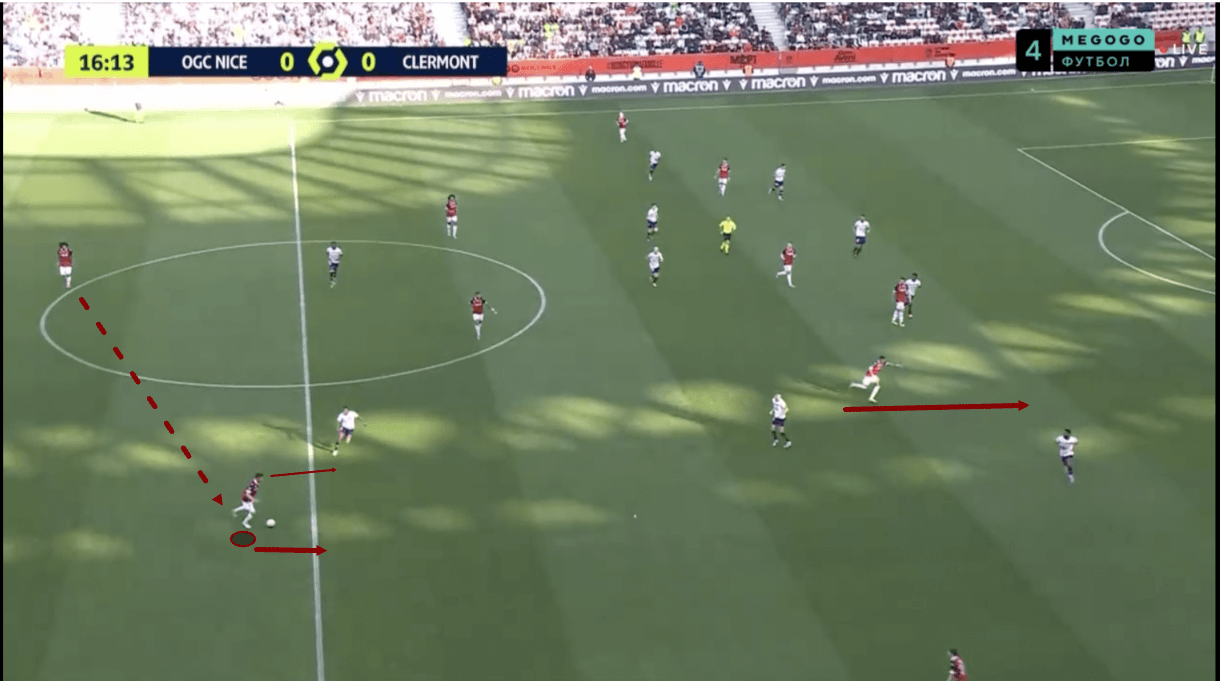
After his Brazilian defensive partner sends him the ball, Daniliuc receives it in a way that’s natural and typical for him — this is how he generally tends to take the ball — on his back foot while opening his body to the space ahead of him and slightly nudging the ball forward so he can then run onto it and continue his momentum forward while lining up his pass/carry.
At the same time, we see Daniliuc using the short bit of time in between his touches to get his head up and scan the pitch ahead of him — looking for incoming pressure and what movement is being offered to him by his teammates.
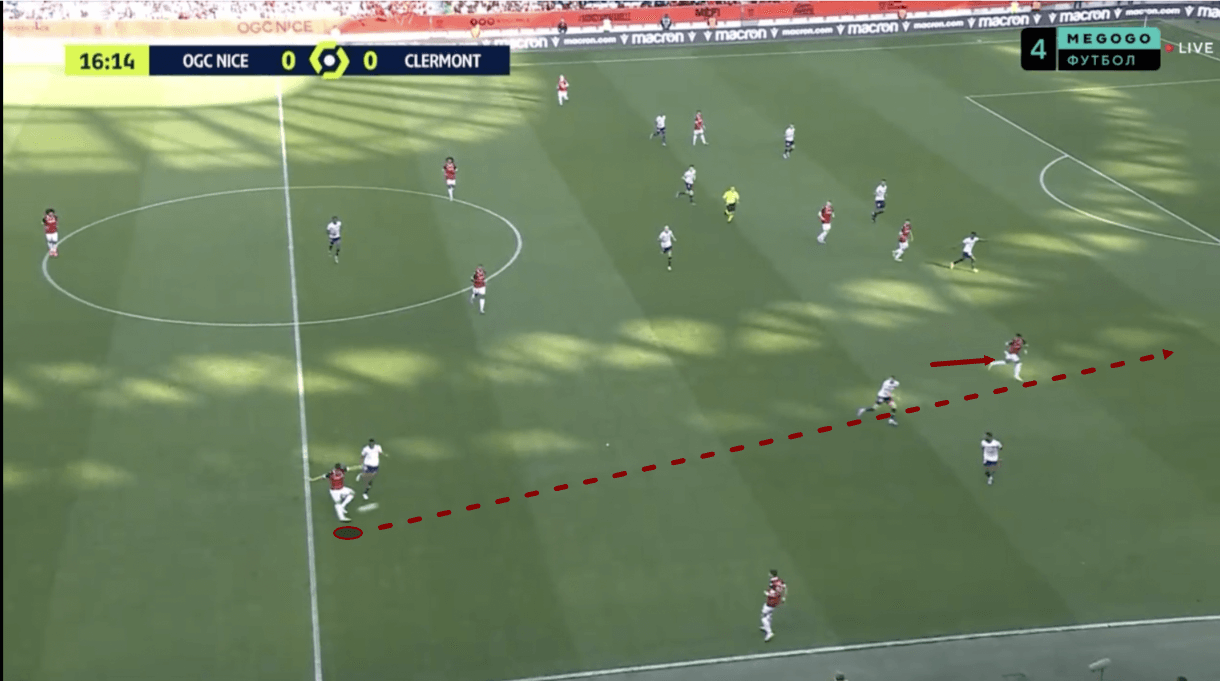
The 21-year-old takes the ball slightly wider while attracting some pressure from the nearest opposition forward. He bides his time while keeping an eye on his teammate’s run directly ahead of him, which he spotted when scanning in figure 5.
In figure 6, the centre-back times his long ball over the top excellently, launching the ball when his teammate has a lot more clear space ahead of him to run into, has advanced quite far up the pitch, yet is still onside and hasn’t required his teammate to check his run. This allows his teammate to accelerate as the ball is sent over the top having already built up some decent pace and break away in behind the opposition’s backline, setting up a good offensive opportunity for Nice.
Daniliuc loves to operate in this kind of position and loves to launch balls forward like this one to directly get his team moving in behind the opposition and into a goalscoring position.
While Daniliuc has played just 3.14 long passes per 90 over the last calendar year, ranking him in the 12th percentile among centre-backs to have played at least 800 minutes in Europe’s top-five leagues in that time, his long pass success rate sits at 71.7%, placing him in the 97th percentile among the same group in that time, highlighting his impressive quality and reliability with long passes.
Furthermore, Daniliuc ranks in just the 35th percentile for what we’ve called ‘positive passing’ — a combination of forward passes per 90, progressive passes (A forward pass that attempts to advance a team significantly closer to the opponent’s goal) per 90 and passes to the final third per 90 — a good indicator of how active someone is in the ball progression phase. However, he ranks in the 84th percentile for positive pass success — again, highlighting his quality and reliability with such passes.
Daniliuc demonstrates some calmness under pressure in figures 5 and 6 above, and this wasn’t a one-off, as the 21-year-old’s composure on the ball under pressure is a notable strength of his game.
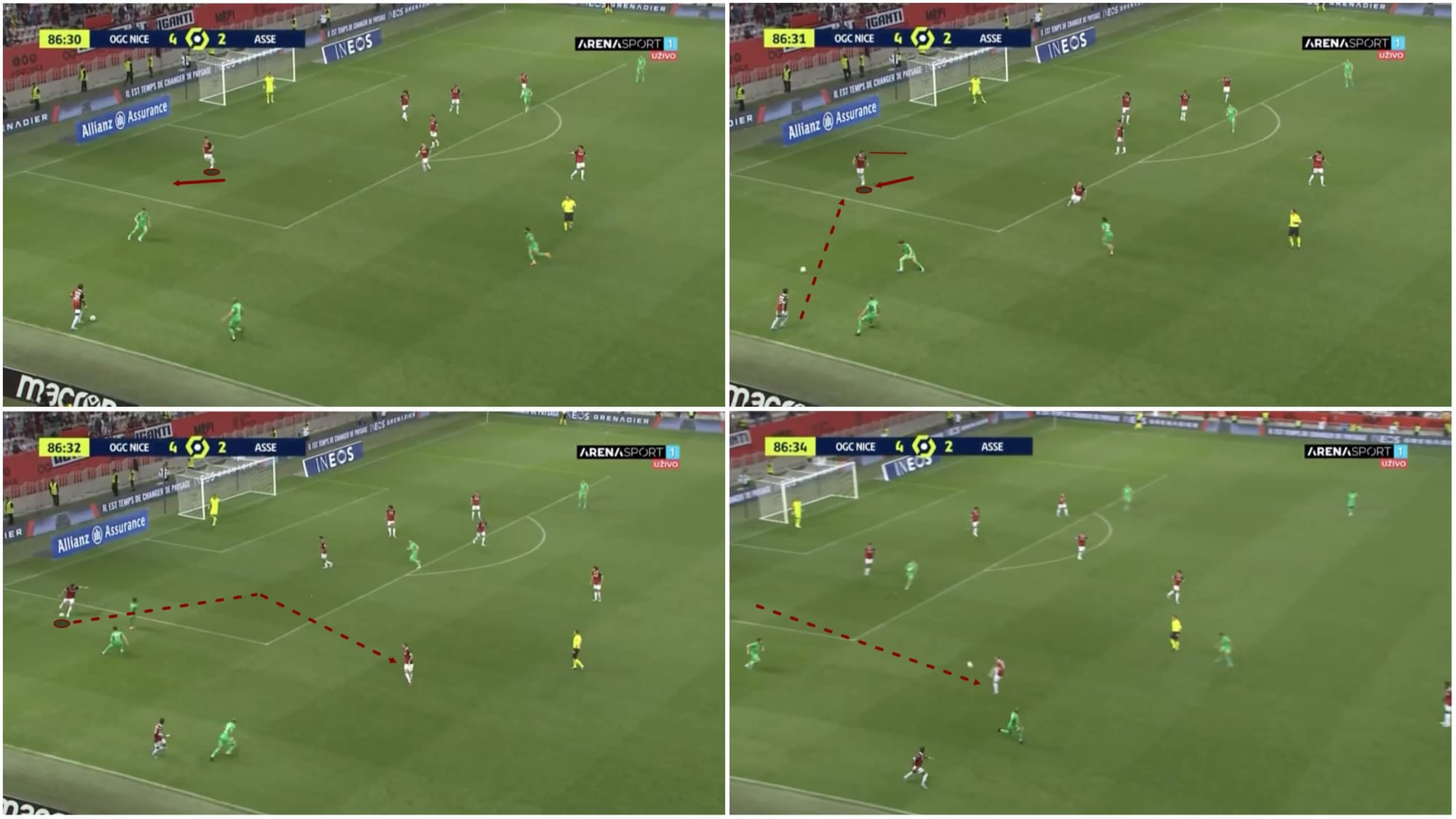
We see another example of this comfort under pressure in figure 7. In the top-left quartile, the centre-back drops to give his teammate on the ball under pressure out wide a safe passing option and escape the opposition player’s cover shadow.
Meanwhile, in the top-right quartile, we see the centre-back scanning the pitch ahead of him while the ball is in motion towards him after leaving the right-back’s foot. This is an intelligent time to scan, just as it was a good decision to scan in between his touches back in figure 5, as the ball won’t drastically change direction or anything at this moment and the centre-back can anticipate its movement towards him. This is a better time to take your eye off the action than when the ball is with a teammate who could perform a sudden action.
After receiving the ball, Daniliuc again allows some pressure to build on him and allows the opposition’s pressing players to get relatively close before he plays his pass up and through those two pressing players in the bottom-left quartile into a free teammate’s feet.
Look at how this space opens up over the course of this move, from the top-left quartile all the way through to the bottom-right quartile of figure 7. It’s clear how Daniliuc’s movement and subsequent composure under pressure to draw opposition bodies further upfield and allow them to close in on him a bit before playing his pass generated space further upfield, just on the edge of his team’s box, for a teammate to exploit.
What happens from here is out of Daniliuc’s hands but it’s clear that his mental and technical ability created a good opportunity for his side to break away here and hurt the opposition.
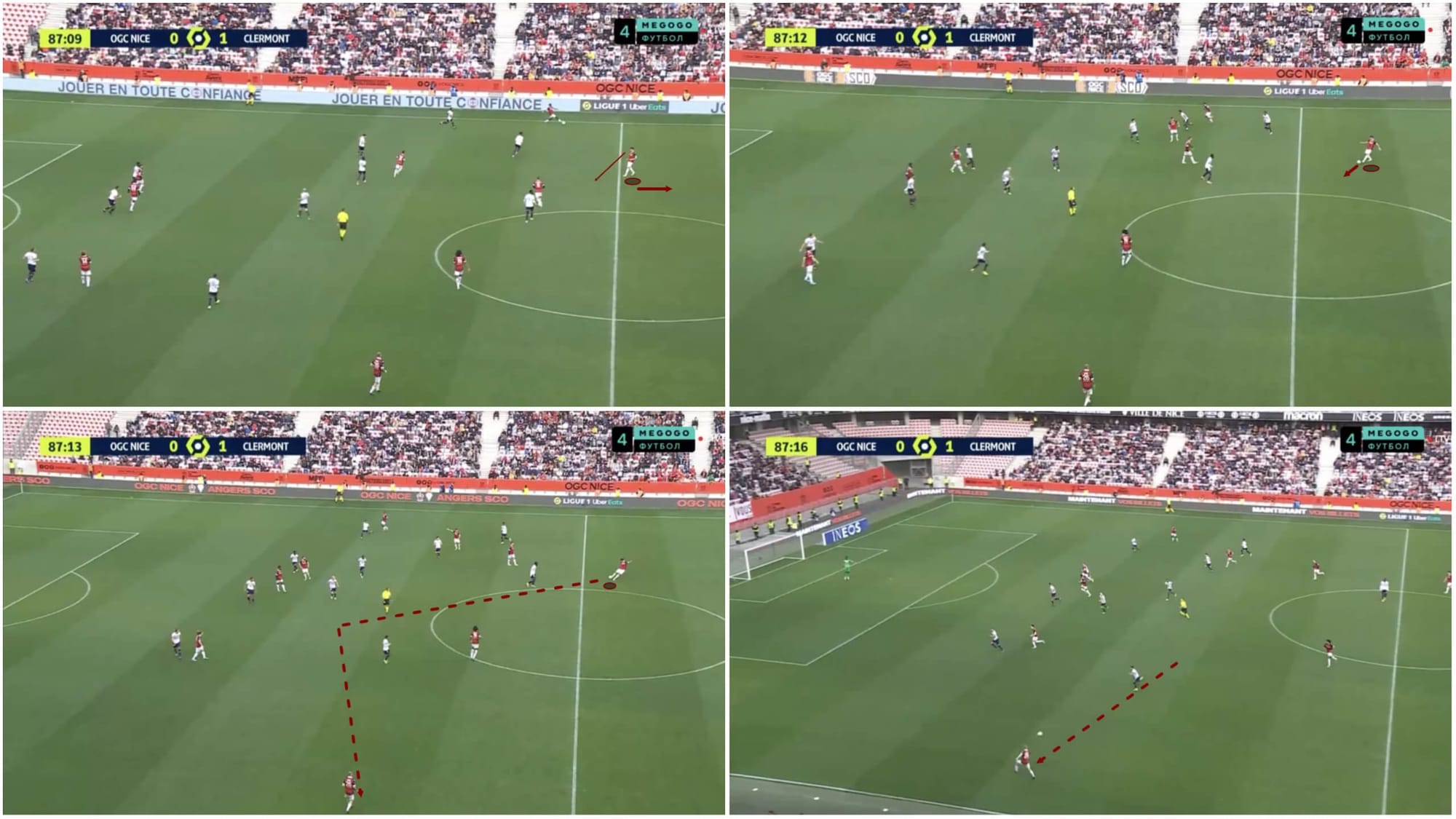
Daniliuc is a great player to have when you want to switch the ball from one wing to the other, as we see in figure 8, as well. The centre-back drops into some space here and receives with time to get the ball out of his feet and get his head up to survey the available options.
He then calmly sweeps the ball up and over to the opposite wing where Nice had a player positioned in plenty of space to welcome the ball and push forward into the final third.
Daniliuc’s vision and technical passing ability are excellent and he would thrive under a coach who trusts his ability on the ball and aims to use it as an offensive tool, as well as a system that allows him to get into the types of positions we’ve seen him occupying in this section of our analysis.
Aggressive defending and physicality
Moving onto Daniliuc’s game without the ball, the centre-back is an aggressive defender who likes to engage the opposition in quite advanced positions.
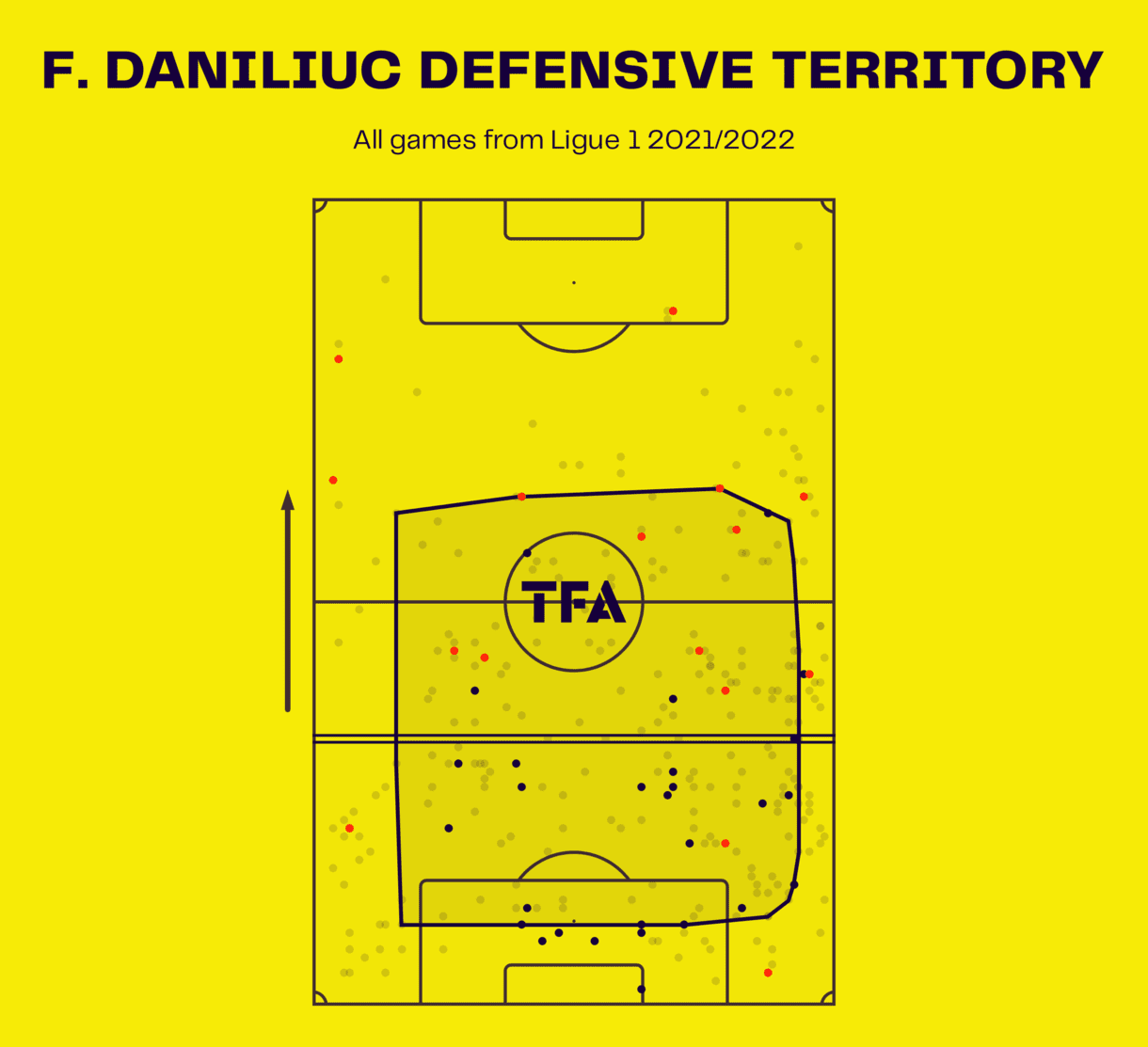
Figure 9 is Daniliuc’s ‘defensive territory’ map from 2021/22. The shaded area is Daniliuc’s average area of defensive engagement, while the lines within that show the height of the centre-back’s average defensive line. Dark blue dots show interceptions and red dots show fouls.
From this map, we get an idea of just how high Danilouc is comfortable going with his defensive engagements, along with the area he typically likes to patrol.
The Austria U21 international ranks in the 93rd percentile for defensive duels per 90 among centre-backs with at least 800 minutes in Europe’s top-five leagues over the last calendar year, indicative of his aggressive nature and comfort with seeking out defensive duels with great regularity.
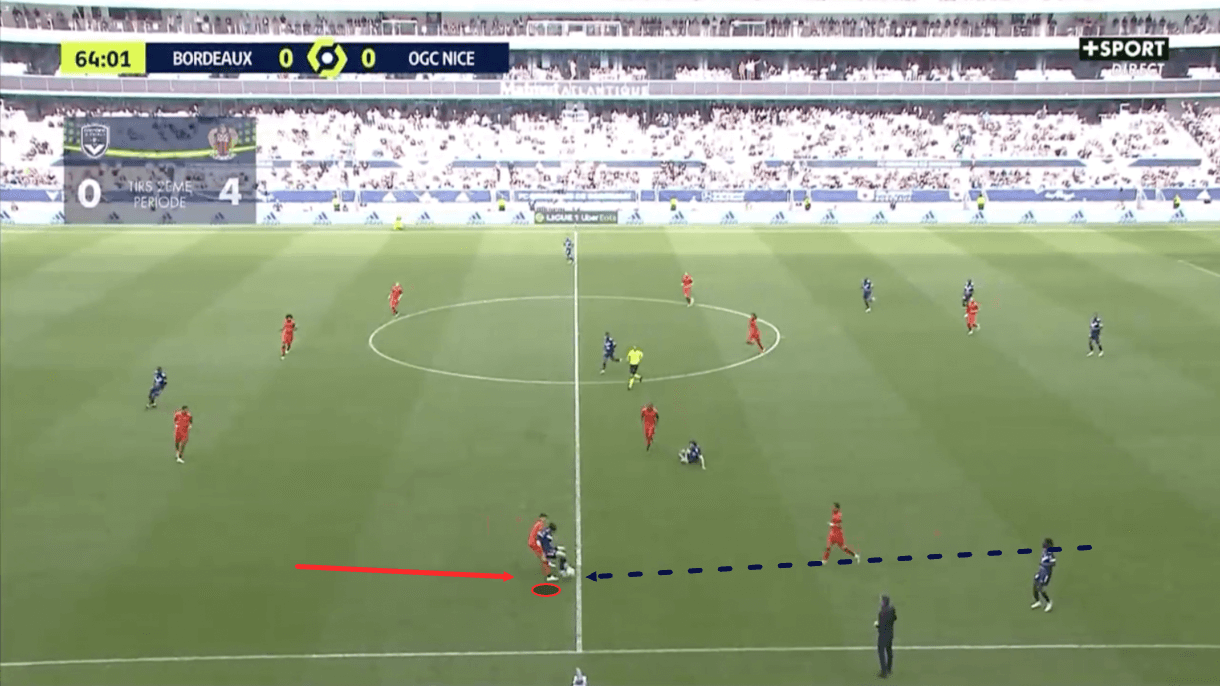
Just before figure 10, the ball was sent upfield by Bordeaux to a man positioned on the left wing with his back to goal. Daniliuc jumped out of the backline and got touch-tight to this player immediately, preventing him from enjoying any space or setting himself to hold up the play.
Daniliuc’s presence and defensive work here prevent the opposition winger from turning on the ball and facing the goal, which would make him far more dangerous. With his back to goal and after getting touch-tight, Daniliuc can better control the player’s movement.
The new Salernitana man doesn’t just want to hold the attacker here, however, he is very aggressive with his challenges too and sticks a foot in to take the ball from the attacker while imposing his body onto the attacker and muscling him away.
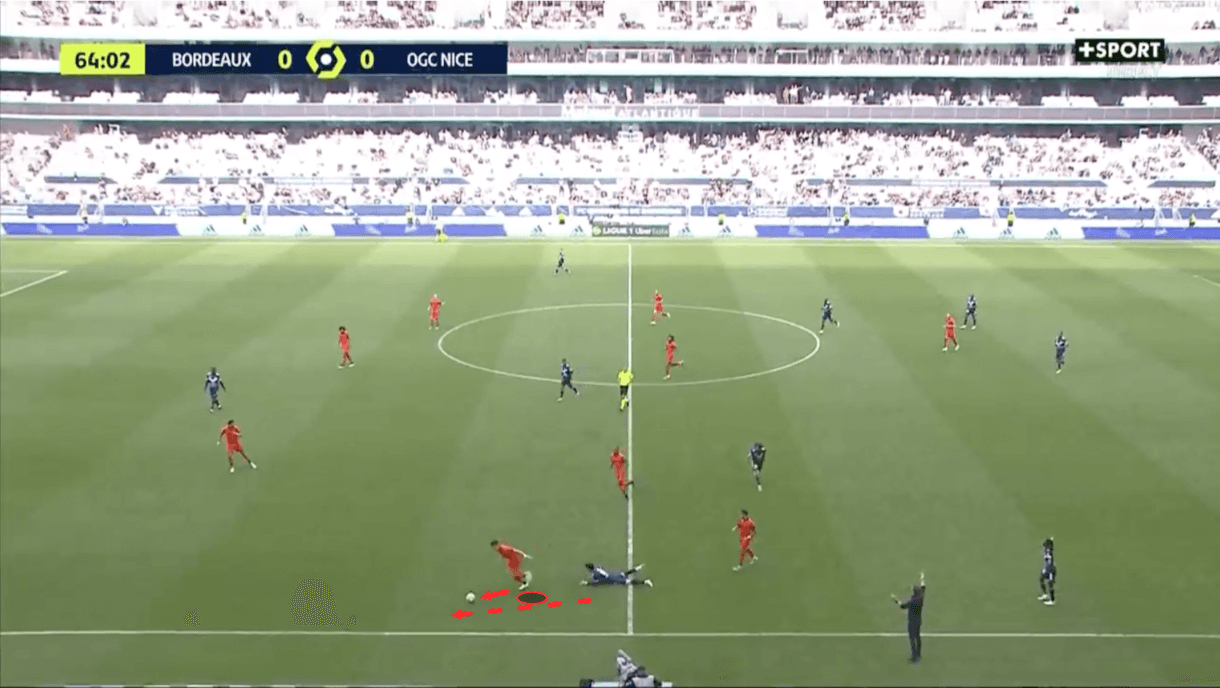
Daniliuc cleanly took the ball while outmuscling the attacker, leading to the Austrian centre-back waltzing away with the ball in figure 11, leaving his opponent eating dirt. Daniliuc went in with one objective here. He didn’t just want to stop the attacker and wait for reinforcements, he wanted to go in, get the ball and come out, which is what he did and is, again, indicative of his aggressive defensive approach.
The former Nice man won’t back down from physical challenges when engaging opponents like this but can bite off a bit more than he can chew at times with more physical attackers. Daniliuc, for all his aggression and physical abilities, can be outmuscled at times — he isn’t the most physical defender in the world, just an aggressive one.
However, there have been times when attackers have set themselves with a nice wide base before the defender gets touch-tight to them, which sets them up well to hold him off and/or successfully back into him. So, Daniliuc’s aggression can be exploited in a way, if the attacker and attacking team prepare well to bait him out of the backline and set themselves in advance of his approach to keeping him held back.
That’s easier said than done, however, in a fast-paced game of top-level football and Daniliuc is quite good at closing attackers down quickly, unbalancing them and thus preventing them from setting themselves to hold him off and ultimately dispossessing them, as we saw in this example.
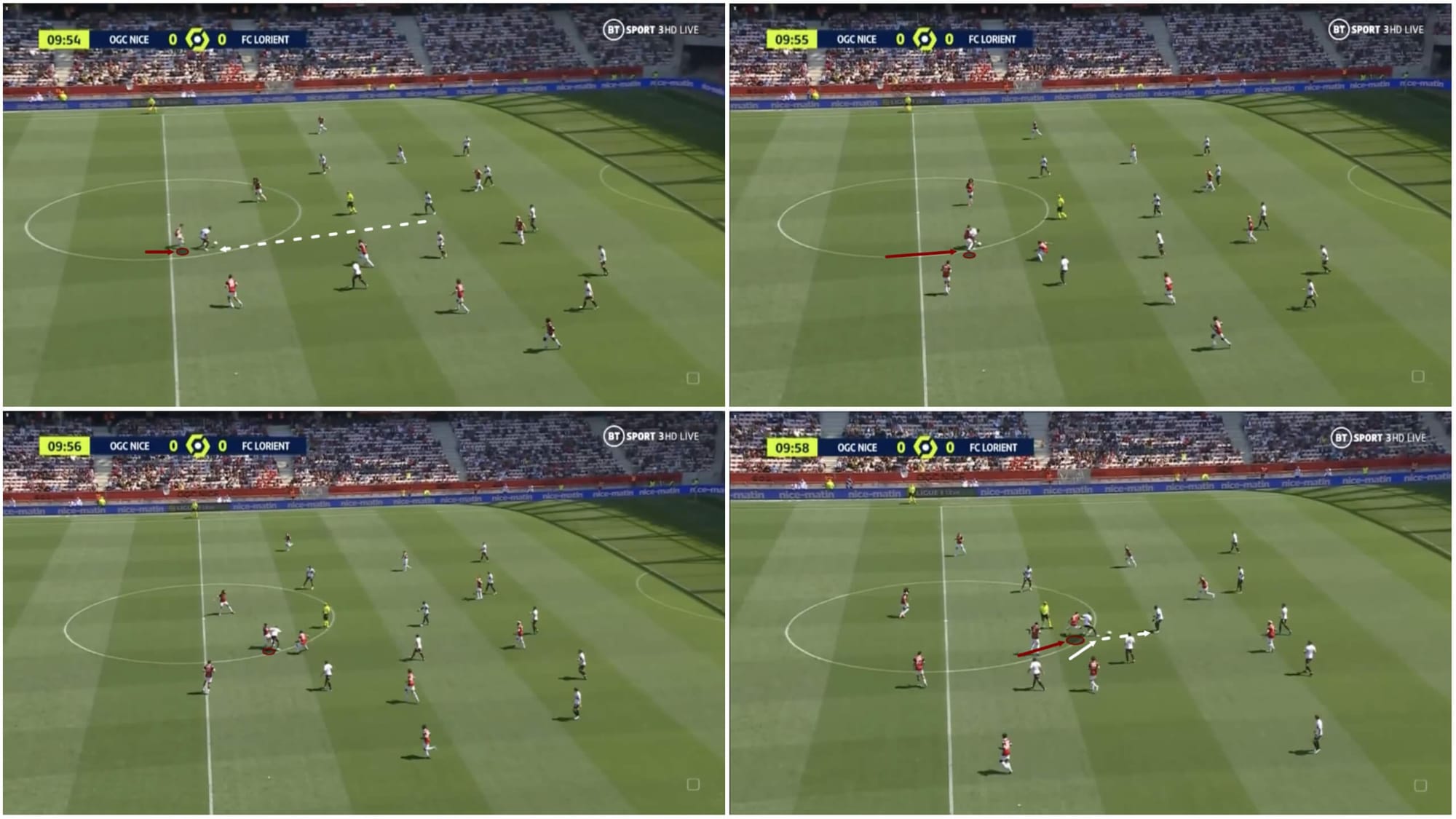
We see another example of Daniliuc’s aggressive approach in figure 12. Here, the ball was sent forward by the opposition to their centre-forward. Daniliuc, then, as the nearest centre-back, was drawn out from the backline naturally with his defensive approach being as it is.
Daniliuc’s nearest defensive partners are then forced to drop back and cover for the aggressive 21-year-old, for fear of the opposition playing around the Austrian centre-back and getting in behind them. We can see the other defenders dropping back to cover for Daniliuc as the play progresses from the top-left quartile to the bottom-right quartile of figure 12.
Again, we see the centre-back jump out of the backline quickly and get touch-tight to prevent the attacker from turning on the ball, which would increase his level of threat a lot. This process is visible in the top half of figure 12.
Moving on into the bottom-left quartile of the image, we see Daniliuc use his quickness, reactions, technical defensive quality and aggressive approach to stop the attacker’s attempt to turn despite Daniliuc’s presence. The attacker tested the Austrian centre-back here and Salernitana’s new man passed the test, continuing to force the attacker backwards.
This passage of play ends in the bottom-right quartile when, with Daniliuc having followed him deep into midfield now and remained touch-tight aggressively forcing him away from Nice’s half, the opposition attacker plays the ball back to a teammate, ending his carry.
At this point, the opposition are clearly in a far worse position than they were when the attack started in the top-left quartile, highlighting Daniliuc’s effective defensive work. Again, the centre-back’s aggression in this situation could have been exploited by a well-prepared team but that too is easier said than done. In reality, the 21-year-old did well to aggressively force the opposition attacker away and end this period of the attack.
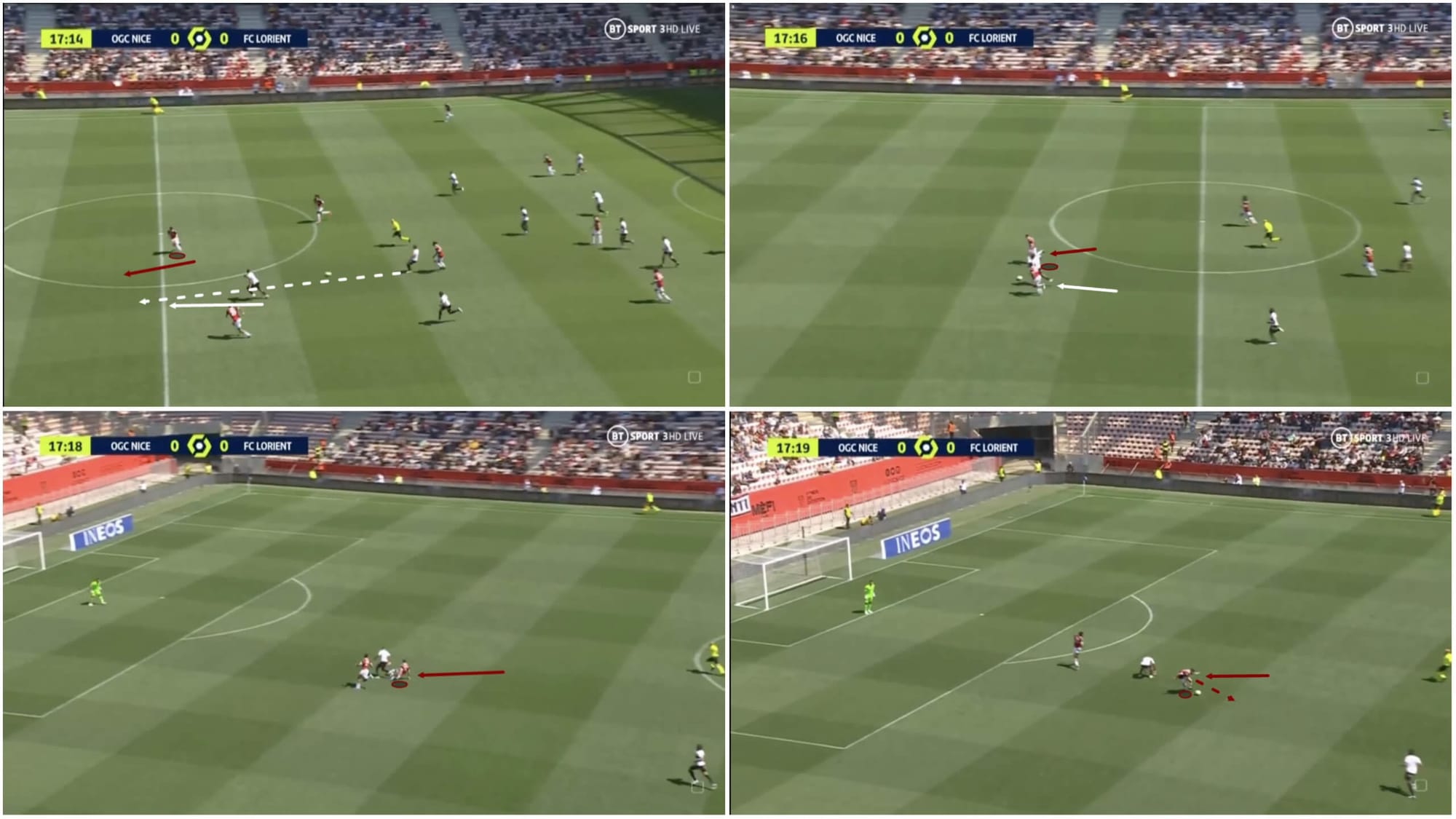
Physically, Daniliuc is quick and this helps him with making recoveries for his team, as was the case in figure 13. Here, the opposition enjoy the opportunity to counterattack Nice and slice right through their defensive line with a well-timed and well-weighted through ball. Daniliuc was the deepest centre-back again on this occasion and was forced to react quickly, tracking back to chase down the attacker and try to clean up the mess for his team.
The player does a great job of staying with the attacker as he receives the ball and tries to drive at Nice’s goal but is forced into a key tackle as the attacker is getting ahead of the Nice defence still.
Daniliuc’s sliding tackle has to be perfectly timed in order to win the ball, and thankfully for Nice, it was. The defender, thanks to his alertness, pace and technical quality, manages to firmly recover the ball and end this opposition attack just on the edge of the Nice penalty area.
This is another example of Daniliuc performing very well under pressure — this time, without the ball as his tackle had to be inch-perfect to pull this off. This is also a great example of Daniliuc’s pace, which is a great physical trait for the team’s centre-back to have both when defending aggressively, in wide areas and in defensive transitions.
One defensive area of improvement for Daniliuc would be his reading of the game and anticipation. There have been times when he’s a little bit too hasty to engage and leaves a passing lane open which could’ve been easily blocked and potentially intercepted had he just been a little more aware.
Additionally, there have been occasions both when defending on the ground and when defending aerially when the centre-back’s anticipation of where the ball is going and where he needs to be have been off, leading to the opposition progressing beyond him. His aerial anticipation, in particular, can improve, as can his jumping.
However, there are plenty of positives to highlight in Daniliuc’s defensive game too, even with the negatives. He’s not a perfect defender by any means but he’s in a good place at 21 with room for improvement in areas that can be polished with time, coaching and experience.
Conclusion
Daniliuc could do well in either a back two or a back three but for us, he would perhaps be better suited to the wide right centre-back position in a back-three, due to his ability and preferences both on and off the ball.
Furthermore, it would be interesting to see the possibility of Daniliuc operating as a wide centre-back with license to overlap and get forward in the style that was popularised by Sheffield United under Chris Wilder. This isn’t a necessity but something that would be very interesting to see and would probably suit Daniliuc’s skill set.
Ultimately, a system that allows Daniliuc to be aggressive off the ball and push forward into the deep right half-space with the ball too would get the best out of him. He needs to be trusted and encouraged to play his expressive game, as he has a great ability to succeed at the top level with his preferred style even with the weaknesses he also presents, as discussed in this article.
Of course, Daniliuc is a young player and things like work ethic day-in-day-out and mentality will be as important as anything in determining to what level he ultimately goes. There is plenty that’s difficult to judge from the outside but he’s a centre-back that we’ve liked during his time in France and could end up proving to be a good bit of business for Salernitana.




Comments